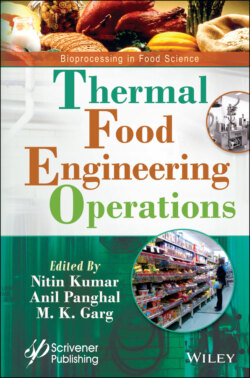Читать книгу Thermal Food Engineering Operations - NITIN KUMAR - Страница 15
1.2.1 Environmental Impact of Novel Thermal Technologies
ОглавлениеThe emergence of novel thermal technologies and non-thermal processes in food processing industries is capable of producing high-quality and standardized products. Both of them are environmentally sound and efficient in nature as compared to conventional technologies. Here we will consider more on the environmental footprints of novel thermal technologies. The primary objective in the food industry is food safety which requires high energy consumption, but novel thermal technologies are successfully able to balance energy saving and energy consumption.
The high value of hygiene and safety of food requires large use of water in both hot and cold cycles in production which consequently increases the environmental footprint. Processes such as cooking, sterilization, drying, and pasteurization require various types of energy. Novel thermal technologies are promising, attractive, and efficient in nature. They are capable of providing improved quality and reduced environmental effects which will eventually reduce environmental footprints. Novel thermal technologies can reduce processing costs followed by improving and maintaining the value-added products. Overall the primary types of energy used based on conventional thermal processing techniques are fossil fuel and electricity, majorly utilized in refrigeration and mechanical power in pumps. A heat exchanger is commonly used in the pasteurization of beverages where the pathogens are killed when heated to a particular residence time. During thermal treatment, convection and conduction play a major role to transfer heat to the products. For viscous fluids, directing heating process is applied, e.g., steam injection and steam infusion are utilized for thermal treatments. In the food and beverages industry, regarding the distribution of energy in 2002, Denmark suggests that total consumption of energy (TJ/Year) is 135,200 including the amount of heating and power. Adapted from [58].
This concludes that major heat is used in frying, evaporation, drying, and heating for thermal processes. Until the present moment, this trend is still functioning. Novel thermal technologies such as radio frequency, ohmic heating, microwave, etc., for food processing being continuously evolving. These novel thermal technologies have reduced emissions, reliability, improved productivity, high product quality, energy saving, water saving and consequently have less impact on the environment; [45] investigated that for Orange juice and cookies manufacturing, radio frequency drying (RF) can range up to 0 to 73.8 TJ per year in terms of primary energy saving. The major kinds of gas emissions from food industries are linked to power and heat production particulate matter and gases such as SO2, CO2, NO, from combustion processes. The particulate matter and volatile organic compounds (VOCs) and other chemical emissions are from methods such as size reduction, heating, refrigeration system, and cooking methods.
Conventionally 33% of the overall energy consumed in food processing corresponds to the production of steam. The steam is commonly used in drying, concentrating liquids, cooking, sterilizing, etc., in the processing of food processes. The generation of steam used in food industries involves the utilization of boilers. To remove the dissolved solid from the boiler system a large quantity of water is periodically drained from the bottom, which is called a blow-down. Inadequate blow-down may lead to the gathering of dirt which reduces the heat transfer rates and increases the loss of energy. Irregular boiler maintenance can decrease the efficiency of the boiler up to 20-30%. The efficiency of a boiler is affected by losses of heat by convection and radiation [58]. Improper boiler maintenance can also emit large emissions of CO2 and loss of energy. [58] also mentions the losses that occurred of a boiler or steam generation system composed of: gases from the combustion of air, or incomplete combustion, radiation losses, boiler blow-down water, heat convection, and fouling of heat transfer surfaces from hot boiler surface. Many attempts have been made to evolve a sustainable sector for lowering the emission of gases, e.g., CO2 and enhance the energy efficiency of devices and methods using renewable energy is now the main concern for every method. Therefore, using electricity in food powering systems may show an environmental benefit as compared to conventional techniques used. Overall novel technologies are considered sustainable, once they reduce the consumption of boilers or steam generation systems and eventually decrease the waste-water, heat loss and increase energy-saving and water-saving as well. Furthermore, the electricity is produced by an eco-friendly source of renewable energy; after that these methods will efficiently contribute to decreasing the pollution, assisting them to protect the environment. [82] shows the balancing by ohmic heating decreased the extent of solid leaching irrespective of the dimensions of the product. It is concluded by [65], OH blanching offers benefit in aspects such as water-saving by maintaining the quality of the processed products. Novel thermal can efficiently accelerate the drying processes when related to traditionally heat pre-treated samples allowing exact control of the process temperature and eventually it can decrease costs of energy, reduce the gas consumption and lower combustion-related emissions [53].
So we can conclude that novel thermal technologies are one of the most novel techniques in food preservation processes. Novel thermal technologies are quite efficient in all aspects such as the efficiency of energy, saving of water, and reduced emissions. Most of the processes involved in novel thermal technologies are green and hence more environmentally friendly, having the least environmental impact as compared to conventional technologies.
